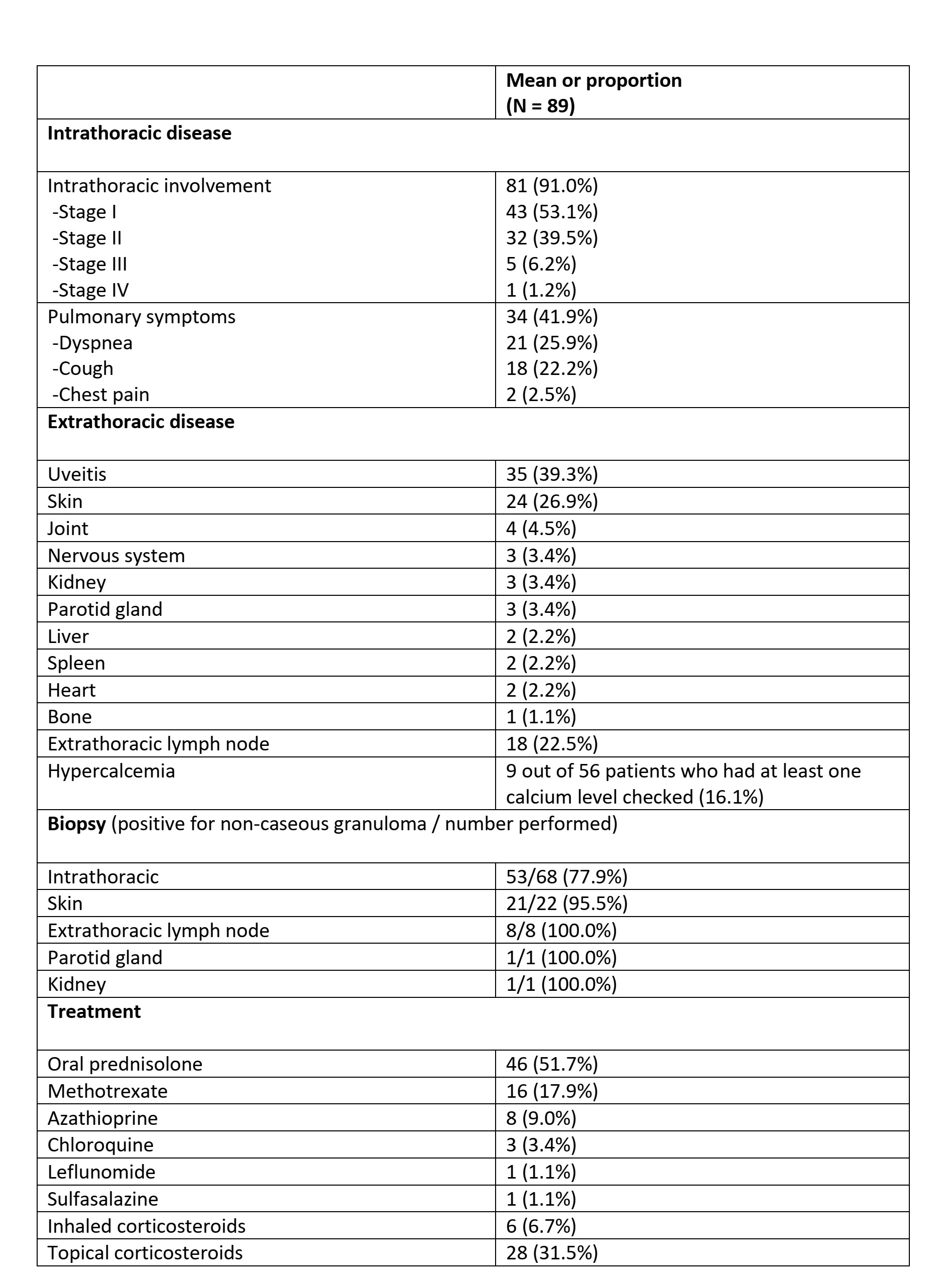Session Information
Date: Sunday, November 8, 2020
Session Type: Poster Session C
Session Time: 9:00AM-11:00AM
Background/Purpose: Data on clinical manifestations of Asians with sarcoidosis are still relatively limited and most of the previously published studies are from East Asia. This study aimed to examine the epidemiology and clinical characteristics of Thai patients with sarcoidosis, using databases of a tertiary care medical center.
Methods: Potential cases of sarcoidosis were identified from two sources, the medical record-linkage system and the pathology database of Siriraj Hospital, Mahidol University in Bangkok, Thailand. Patients with ICD-10-CM codes for sarcoidosis were identified and retrieved from the medical record-linkage system from 2005 to 2018. Patients with histopathology positive for non-caseating granuloma were identified and retrieved from the pathology database from the same time period. All potential cases underwent individual medical record review to confirm the diagnosis of sarcoidosis which required compatible clinical pictures supported by presence of non-caseating granuloma after exclusion of other granulomatous diseases. A standardized case record form was used to record demographics, clinical manifestations and treatment of confirmed sarcoidosis cases.
Results: From 2005 to 2018, 89 confirmed cases of sarcoidosis were identified. There was female predominance (80.9%) with mean age at diagnosis of 46.8 years (standard deviation [SD] 13.9 years) and mean follow-up time of 5.4 years (SD 4.5 years). The majority of patients with sarcoidosis in this cohort had intrathoracic disease (81 cases; 91.0%). About half of them had stage I pulmonary sarcoidosis (43 cases; 53.1%) followed by stage II (32 cases; 39.5%), III (5 cases; 6.2%) and IV (1 case; 1.2%). However, less than half of patients with intrathoracic disease were symptomatic (34 cases; 41.9%) with dyspnea and cough being the most common symptoms (25.9% and 22.2%, respectively). The yield of intrathoracic biopsy was fair that histopathology was positive for non-caseating granuloma in 53 of 68 patients (77.9%) who underwent biopsy.
Extrathoracic disease was common in this cohort that pulmonary sarcoidosis was accompanied by extrathoracic involvement in 53 patients (65.4%). Isolated extrathoracic disease was observed in 8 patients. Sarcoid uveitis was the most common extrathoracic disease (35 cases; 39.3%; 4 males and 31 females) followed by cutaneous sarcoidosis (24 cases; 26.9%). Calcium was tested in 56 patients and hypercalcemia was seen in 9 of them (16.1%). Biopsy of extrathoracic organs appeared to have a high sensitivity with 21 of 22 skin biopsies and all 8 extrathoracic lymph node biopsies showed evidence of non-caseating granuloma.
A total of 48 patients (53.9%) received at least one systemic treatment during the course of their illness. The most commonly prescribed systemic treatment was oral prednisolone (46 cases; 51.7%) followed by methotrexate (16 cases; 17.9%), azathioprine (8 cases; 9.0%) and chloroquine (3 cases; 3.4%) (Table 1).
Conclusion: The current study described clinical characteristics of sarcoidosis in an Asian population. The most prominent findings that are different from sarcoidosis in other ethnic groups included the high prevalence of uveitis and the marked female predominance.
 Table 1: Characteristics of patient with sarcoidosis in the current study
Table 1: Characteristics of patient with sarcoidosis in the current study
To cite this abstract in AMA style:
Tripipitsiriwat A, Komoltri C, Ruangchira-Urai R, Ungprasert P. Clinical Characteristics of Sarcoidosis in Asian Population: A 14-year Single Center Retrospective Cohort Study from Thailand [abstract]. Arthritis Rheumatol. 2020; 72 (suppl 10). https://acrabstracts.org/abstract/clinical-characteristics-of-sarcoidosis-in-asian-population-a-14-year-single-center-retrospective-cohort-study-from-thailand/. Accessed .« Back to ACR Convergence 2020
ACR Meeting Abstracts - https://acrabstracts.org/abstract/clinical-characteristics-of-sarcoidosis-in-asian-population-a-14-year-single-center-retrospective-cohort-study-from-thailand/
